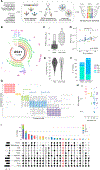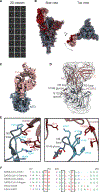Deep repertoire mining uncovers ultra-broad coronavirus neutralizing antibodies targeting multiple spike epitopes
- PMID: 38848216
- PMCID: PMC11671098
- DOI: 10.1016/j.celrep.2024.114307
Deep repertoire mining uncovers ultra-broad coronavirus neutralizing antibodies targeting multiple spike epitopes
Abstract
The development of vaccines and therapeutics that are broadly effective against known and emergent coronaviruses is an urgent priority. We screened the circulating B cell repertoires of COVID-19 survivors and vaccinees to isolate over 9,000 severe acute respiratory syndrome coronavirus 2 (SARS-CoV-2)-specific monoclonal antibodies (mAbs), providing an expansive view of the SARS-CoV-2-specific Ab repertoire. Among the recovered antibodies was TXG-0078, an N-terminal domain (NTD)-specific neutralizing mAb that recognizes diverse alpha- and beta-coronaviruses. TXG-0078 achieves its exceptional binding breadth while utilizing the same VH1-24 variable gene signature and heavy-chain-dominant binding pattern seen in other NTD-supersite-specific neutralizing Abs with much narrower specificity. We also report CC24.2, a pan-sarbecovirus neutralizing antibody that targets a unique receptor-binding domain (RBD) epitope and shows similar neutralization potency against all tested SARS-CoV-2 variants, including BQ.1.1 and XBB.1.5. A cocktail of TXG-0078 and CC24.2 shows protection in vivo, suggesting their potential use in variant-resistant therapeutic Ab cocktails and as templates for pan-coronavirus vaccine design.
Keywords: CP: Immunology; CP: Microbiology.
Copyright © 2024 The Authors. Published by Elsevier Inc. All rights reserved.
Conflict of interest statement
Declaration of interests D.B.J., B.A.A., M.J.T.S., and W.J.M. were employees and shareholders of 10× Genomics, Inc., at the time this work was performed. D.B.J., B.A.A., M.J.T.S., and W.J.M. are inventors on patents in relation to algorithms, therapeutic candidates, and other components of this work. W.J.M. and D.B.J. are founders, employees, and shareholders of Infinimmune. B.B. is a shareholder of Infinimmune and a member of its scientific advisory board.
Figures




Update of
-
Deep repertoire mining uncovers ultra-broad coronavirus neutralizing antibodies targeting multiple spike epitopes.bioRxiv [Preprint]. 2023 Mar 31:2023.03.28.534602. doi: 10.1101/2023.03.28.534602. bioRxiv. 2023. Update in: Cell Rep. 2024 Jun 25;43(6):114307. doi: 10.1016/j.celrep.2024.114307. PMID: 37034676 Free PMC article. Updated. Preprint.
References
-
- Drosten C, Günther S, Preiser W, van der Werf S, Brodt H-R, Becker S, Rabenau H, Panning M, Kolesnikova L, Fouchier RAM, et al. (2003). Identification of a novel coronavirus in patients with severe acute respiratory sy"ndrome. N. Engl. J. Med. 348, 1967–1976. - PubMed
MeSH terms
Substances
Supplementary concepts
Grants and funding
LinkOut - more resources
Full Text Sources
Other Literature Sources
Medical
Miscellaneous

